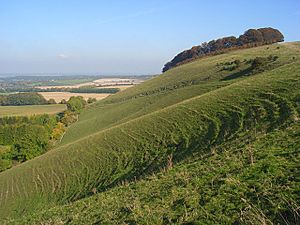Ham Hill, Wiltshire facts for kids
| Site of Special Scientific Interest | |
 |
|
| Area of Search | Wiltshire South |
|---|---|
| Coordinates | 51°21′12″N 1°31′24″W / 51.3534°N 1.5232°W |
| Interest | Biological |
| Area | 1.5 hectares |
| Notification | 1971 |
Ham Hill is a special place in Wiltshire, England. It's a beautiful area of chalk downland. You can find it on the steep hills next to the road between the villages of Ham and Buttermere. It's also quite close to the border of Berkshire.
This amazing spot is known as a Site of Special Scientific Interest (SSSI). This means it's protected because it has very important plants and insects. It was first protected in 1971. The SSSI part of Ham Hill is about 1.5 hectares big. That's roughly the size of two football fields!
One of the most exciting finds here is the rare musk orchid. This special flower has only been found in one other place in all of Wiltshire. Ham Hill is also looked after by the Wiltshire Wildlife Trust. They manage it as a nature reserve.
Contents
Discover Ham Hill's Nature!
Ham Hill is a fantastic place to explore nature. It has many different kinds of plants and animals. The hillsides are covered in short, grassy areas. These areas are full of many types of herbs. Flatter parts of the site have taller plants.
Amazing Plants of Ham Hill
The main plants you'll see growing here are different types of grasses. These include upright brome, sheep's fescue, and quaking-grass. You'll also find many pretty downland herbs. Some of these are burnet-saxifrage, salad-burnet, common milkwort, and dwarf thistle. Another interesting plant is squinancywort.
Ham Hill is home to many plants that love chalky soil. These include the clustered bellflower and autumn gentian. You can also spot chalk milkwort, horseshoe vetch, and common rockrose. Both the clustered bellflower and autumn gentian grow in large numbers here.
Rare Orchids at Ham Hill
Ham Hill is super important for orchids. It's one of only two places in Wiltshire where the rare musk orchid grows. But that's not all! You can find seven other types of orchids here too. These include the frog orchid, burnt orchid, and fragrant orchid.
Tiny Plants: Bryophytes
Even tiny plants are special here. You can find small mosses and liverworts. These are called bryophytes. Some examples are the liverwort Leiocolea turbinata. There are also mosses like Ctenidium molluscum, Dicranella varia, Weissia microstoma, and Entodon concinnus.
Cool Critters at Ham Hill
Ham Hill is a great place for insects, especially butterflies! You might see a group of Duke of Burgundy butterflies flying around. Other beautiful butterflies that live on chalky grasslands are also here. Look out for the green hairstreak, dingy skipper, dark green fritillary, and chalkhill blue.
The Giant Snail
Keep an eye out for the Roman snail! This is the biggest snail you can find in Britain. It makes its home here at Ham Hill.
How Ham Hill is Cared For
The Wiltshire Wildlife Trust works hard to keep Ham Hill healthy. They manage it as a nature reserve. To help the rare plants grow, they let sheep graze on the land. The sheep eat the taller, common plants. This stops them from growing too much and crowding out the more special, smaller plants. This way, all the amazing species can thrive!

